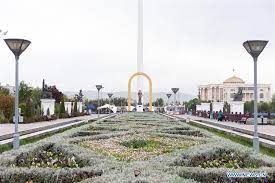The world is a busy place, with politics changing and events happening all the time. However, we make it simple to quickly read all the pertinent data for every country, in addition to flag details and an atlas summary for what kind of general information you are most interested in.
The following basic facts and information are covered in detail in each Country’s Profile:
Maps, geography, Brief history, the current ruler, area, population, capital, and largest cities – Languages-Race and ethnicity – Faith – Rate of literacy and The economy.
Facts & Information about Tajikistan
Let’s explore everything you need to know about Pakistan. Check out our country profile, full of essential information about Oman’s geography, history, government, economy, population, culture, religion, and languages.
Flag Of Tajikistan

Map Of Tajikistan

President: Imomali Rakhmonov (1992)
Prime Minister: Akil Akilov (1999)
Land area: 55,251 sq mi (143,100 sq km)
Total area: 55,251 sq mi (143,100 sq km)
Population (2014 est.): 8,051,512 (growth rate: 1.75%)
Birth rate: 24.99/1000
Infant mortality rate: 35.03/1000
Life expectancy: 67.06
Density per sq mi: 125.8
Capital and largest city (2014 est.): Dushanbe, 778,500
Other large city (2014 est.): Khujand, 584,400 (metro area)
Monetary unit: somoni
National name: Jumhurii Tojikiston
Languages: Tajik (official), Russian widely used in government and business
Ethnicity/race: Tajik 79.9%, Uzbek 15.3%, Russian 1.1%, Kyrgyz 1.1%, other 2.6% (2000)
Religions: Islam: Sunni 85%, Shiite 5%; other 10% (2003 est.)
Literacy rate: 99.7% (2011 est.)
Economic summary: GDP/PPP (2013 est.): $19.2 billion; per capita $2,300
Real growth rate: 7.4%
Inflation: 3.7%
Unemployment: 2.5% official rate; actual unemployment is higher
Arable land: 5.96%
Agriculture: cotton, grain, fruits, grapes, vegetables; cattle, sheep, goats
Labor force: 2.209 million (2013); agriculture 46.5%, industry 10.7%, services 42.8% (2013 est.). Industries: aluminum, cement, vegetable oil
Natural resources: hydropower, some petroleum, uranium, mercury, brown coal, lead, zinc, antimony, tungsten, silver, gold
Exports: $1.163 billion (2013 est.): aluminum, electricity, cotton, fruits, vegetable oil, textiles
Imports: $4.121 billion (2013 est.): petroleum products, aluminum oxide, machinery and equipment, foodstuffs
Major trading partners: Turkey, Switzerland, Russia, Kazakhstan, China, Ukraine, Lithuania, Iran, Kyrgyzstan, Afghanistan (2012)
Communications
Telephones: main lines in use: 393,000 (2012); mobile cellular: 6.528 million (2012)
Radio broadcast stations: AM 4, FM 4, shortwave 2 (2010). Radios: 1.291 million (1991)
Television broadcast stations: 19 (2010)
Televisions: 820,000 (1997)
Internet Service Providers (ISPs): 6,258 (2012)
Internet users: 700,000 (2009)
Transportation
Railways: total: 680 km (2008)
Highways: total: 27,767 km (2000)
Ports and harbors: none
Airports: 24 (2013)
International disputes: In 2006, China and Tajikistan pledged to commence demarcation of the revised boundary agreed to in the delimitation of 2002; talks continue with Uzbekistan to delimit border and remove minefields; disputes in Isfara Valley delay delimitation with Kyrgyzstan.
Geography
Ninety-three percent of Tajikistan’s territory is mountainous, and the mountain glaciers are the source of its rivers. Tajikistan is an earthquake-prone area.
The republic is bounded by China in the east, Afghanistan to the south, and Uzbekistan and Kyrgyzstan to the west and north. The Central Asian Republic also includes the Gorno-Badakh Shan Autonomous region. Tajikistan is slightly larger than the state of Illinois.
History
The Tajiks, whose language is almost exactly the same as Persian, were a part of the Darius I-ruled Persian Empire until Alexander the Great (333 B.C.) overthrew it. Arabs brought Islam to the area when they conquered it in the seventh and eighth centuries.
Before Russia claimed the Tajiks in the 1860s, the Uzbeks and Afghans reigned over them in turn. Following its consolidation into a new Tajik Autonomous Soviet Socialist Republic in 1924, Tajikistan was administratively a member of the Uzbek SSR until 1929, when the Tajik ASSR attained full republic status.
In August 1990, Tajikistan proclaimed its independence. The Communist leadership of the country backed the attempted overthrow of Soviet President Mikhail Gorbachev in 1991. On December 21, 1991, Tajikistan became a member of the Commonwealth of Independent States together with 10 other former Soviet republics.
In November 1992, the presidential system was abolished and a parliamentary republic was established. Following its independence, Tajikistan had intermittent warfare as the government, which was headed by the Communist party, battled an uprising led by opposition groups that were democratic and Islamic.
Periodic combat persisted in the civil war despite ongoing international efforts to put an end to it. Approximately 60,000 people died in the civil war in Tajikistan. On June 27, 1997, the United Tajik Opposition (UTO), a coalition of mostly Islamic organizations, and President Imomali Rakhmonov’s administration signed peace treaties in Moscow, formally putting an end to the conflict. Since then, though, the calm has been shaky and frequently interrupted by killing sprees carried out by different opposition organizations.
International monitors declared the 2005 parliamentary elections illegal despite the president’s governing party receiving 80% of the vote. In November 2006, President Rakhmonov was re-elected to a third term despite the opposition parties’ boycott.
He has imprisoned opposition leaders and closed down the nation’s independent media since taking office ten years ago. Additionally, his government has been charged with corruption and violations of human rights.

Leave a Reply